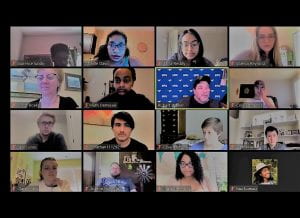by Ashton Reynolds

Background
This past summer, I served as a Project Manager for the Class of COVID Oral History Project. This project was initially conceived to record and document the feelings, thoughts, and actions of students graduating from SMU in the COVID disrupted 2020 spring semester. Additionally, we were interested in how the faculty and staff who assisted those students navigated the unexpected trials and hurdles brought on by COVID. However, not long into June, it became clear that this project represented more than our participants’ reflections of the spring semester. Our project found itself in the midst of a pandemic that would extend past the spring and be met with the largest civil unrest since the Civil Rights Movement. The Class of COVID project was indelibly shaped by the history it sought to record.
Naturally, the necessary resource for an oral history project is people to interview. Our team took a multifaceted approach to identifying possible interviewees. We contacted the appropriate university office for a list of graduating students. In addition to that, we contacted individual departments within the various colleges of the university for assistance in identifying graduating students they felt might be interested in participating in our project. Finally, and with perhaps the most success, we reached out to people within our own academic and social circles at SMU to interview. These people not only provided us with fruitful interviews about their own lives and experiences; they also made beneficial suggestions for other interviewees.
Because of the pandemic, all of our interviews were conducted via Zoom. Once the interviews were recorded into Zoom, we uploaded them into a transcription software program called Otter. Once Otter returned the transcripts to us, we then proofread the transcript for accuracy. After our initial edit of the transcripts, we sent them to another team member to review. When the transcript was fully vetted, it was then added into Box along with its pertinent information and metadata to be archived in the SMU archives. In order to facilitate the most truthful answers to our questions, our team agreed to embargo each interview for 16 years, with confidential access limited to SMU students and faculty conducting applicable research.
Approach to Ethics
I approached Class of COVID from both ethical and historical perspectives. My grant from the Maguire Center not only necessitated an ethical approach but gave me license to pursue an investigation of present events and people’s responses to them as a trained historian. While historians work in the past, the impetus of our investigations is very much based in the present. Michel-Rolph Trouillot writes in Silencing the Past: Power and Production of History that the past itself is only the past because of its relation to the present.
The past exists “over there” only because we are “here.” Pastness, events that we conceive of as before our time, are less a reality and more a position of our conception. We remember and consider events of the past from the values and concerns of the current moment. As a historian and a person who has grown increasingly concerned with our present ethical considerations in light of the pandemic, our work caused me to wonder about the vitality of our project overtime. I wondered if future societies would revisit our research as an ethical framework for evaluating what they perceived as the past.
Line of Questioning
We wanted our line of questioning to be as objective as possible in order to gain clear and honest answers from interview participants. We did not want our interviewees to answer our questions in ways that suited our preferences. Instead, we wanted honest and unvarnished information. In this vein, we chose a tone of inquiry that avoided confrontation. However, we did ask one question that was more direct – and possibly jarring – than the others. We wondered,
“What do you think your responsibilities are as a human during the pandemic?”
We ended the interview with this question. And although it was asked with no motives for emotional disruption, the very nature of the question makes presumptions about the validity of personal responsibility during a crisis, which could possibly prompt internal/and or external conflict. The answer to this question goes beyond a simple reaction. Interviewees must delve into introspection about what humanity means to them and their place within the community of humanity. Arguably, it is impossible for one to express individual humanity apart from community.
Historical Perspective As a history PhD student, I spent the summer conducting research for my dissertation as I simultaneously worked on Class of Covid. As I considered the answer to our question about human responsibility, I considered the way this question is considered within the academic discipline of history. For example, as I read Alan Taylor’s American Colonies, I was struck by the way Christopher Columbus evaluated the indigenous peoples he encountered as not fully human until they adopted Christianity and paid some type of penance. The idea of penance was used to justify Columbus’ decision to enslave them.
As a history PhD student, I spent the summer conducting research for my dissertation as I simultaneously worked on Class of Covid. As I considered the answer to our question about human responsibility, I considered the way this question is considered within the academic discipline of history. For example, as I read Alan Taylor’s American Colonies, I was struck by the way Christopher Columbus evaluated the indigenous peoples he encountered as not fully human until they adopted Christianity and paid some type of penance. The idea of penance was used to justify Columbus’ decision to enslave them.
Simultaneously, I read Benjamin Park’s Kingdom of Nauvoo: The Rise and Fall of a Religious Empire on the American Frontier which describes the struggles of the Mormons to be seen as human both in light of the Missouri Executive Order 44, also known as the Mormon Extermination Order, and their struggle to thrive as a marginalized group in a democratic system that privileged the majority. Previous research for my MA thesis examined the ways in which African American Baptists and Methodists during Reconstruction in Texas refused to accept less-than-human offerings of fellowship from white church members and chose instead to form their own church bodies where they could express the full dignity of their humanity.
These examples of ways in which people have used power to objectify and degrade others have caused me to believe that times of trial do not bring out the best in societies. I used to be more optimistic, but I am less sure as I study history and live through our current times. Conversely, my research with Class of COVID has led me to conclude that many, if not most people, are very concerned with personal ethics. Certainly, our interviewees do not want to get the virus.
But through our interviews, I noticed that the overwhelming pattern was that the safety of others dominated our participants’ concern. This leads me to ponder whether the personal ethics that guide the individual will guide society as a whole. Will individual responsibility translate into public virtue? I believe there is a disconnect between the personal ethics of individuals and the communal ethics instituted by institutions, organizations, and governments. Granted, our Covid project presents only a small sample of people. But it is clear that the personal ethics of people who prioritize the welfare of others often isn’t visible in the goals of the larger bodies these individuals comprise.
This does not mean that institutions, organizations, and governments are completely devoid of an ethical framework to care for the wellbeing of the people who are affected by their decisions. I do think, however, that fully considering the humanity of the individuals that comprise these larger groups complicate how institutions attain their goals and needs. This is a well-worn historical pattern and not new to the COVID-19 era. For example, although the First Amendment guarantees religious freedom, there was once fear that Mormon’s threatened to upset the balance of political power in the expanding United States because of their reputation for operating in political solidarity.
Another example is the refusal of white churches in Texas and across the South to grant African Americans full membership within their congregations, despite the progress of the 13th, 14th, and 15 amendments. African-Americans were functionally abandoned by white congregants and the Republican party in the name of “healing the nation.” This leaves me pondering, why do institutions, organizations, and governments eschew the creativity and courage to accomplish their goals and needs in an ethical manner that considers the full humanity of the individuals without whom they could not exist?
“Greater Good”
The answer must be that institutions, in contrast to many of the individuals we interviewed for Class of COVID, make their ethical decisions based on institutional survival which allows great latitude in sacrificing the individuals who comprise them under the banner of ensuring the “greater good.” What is insidious about the “greater good” is how easily it becomes a neat default for institutions and their leaders to avoid the hard work of creativity and compassion. The “greater good” is a salve to the conscience of institutions and their leaders that is unavailable to rank and file individuals that comprise the institutions.
Individuals must confront their humanity, one way or the other. They can choose to eschew empathy and the action that derives from it, but they run the risk of rightly being judged inhumane for it. Institutions and their leaders on the other hand can look at the faceless, story-less individual and jettison their wellbeing or association. Here we recognize that the “greater good” does not equate to “greater majority.” The “greater good” is the idea of the institution, paradoxically, not the individuals who comprise it.
Too often we look to the past for motivation for our ethical structures of the present. If we take Trouillot at his word and view the past not as something of substance, but a position dependent on the present, then we can reorient the source of our ethics where it belongs, in the present. Historical justifications, after all, are really simply dressed-up present desires. If institutions do one thing well, it is the positive creation of their own history. Their histories tend to emphasize the accomplishments and trials of the institution, drawing in the histories of individuals that serve the institution’s interests, as needed. While this is a good historical approach for institutional survival and promotion, it is a poor approach for confronting ethical challenges brought on by events like pandemics. It develops institutional glory, which is at best useless when confronting ethical challenges, and sometimes it is much worse.
Institutions must eschew institutional glory for institutional empathy. To accomplish this, institutions – be they government, university, religious body, or corporation — must accept the notion of the past as a concept relative to our present reality. With this mentality, the histories of the individual are not subsumed, or even redacted, to the history of the institution, but become pertinent and visible as a crucial part of the institution. Once his/her history is accepted, the individual’s present realities and worth become undeniable. Thus, the institution truly acts in its own benefit, as it becomes fully aware that it only exists through the individuals who comprise it. Empathy is then the derivative of institutional history and not the illusion of glory.









 Neth acknowledges the gender inequalities that existed even in most cooperative family farms; however, men, women, and children cast aside such inequalities to preserve their farms as agribusiness grew in the Midwest. While historians have characterized such instances as opportunities for women’s resistance, Neth argues that Midwestern women put their families before themselves. By participating in field labor and family care, women created commodities such as poultry flocks and eggs for their families as well as the market. Also, young boys and girls dug and planted potatoes, picked berries, and set tobacco. Families utilized these subsistence mechanisms to stabilize their household budgets, so they would not be bought off by agribusiness agents. Neth describes how certain commodities required women’s labor. For example, in Wisconsin, mothers and daughters gathered tobacco. Since farmers could not afford to employ many laborers, all family members often worked together in tobacco fields. Thus, families kept some of their purchasing power by not hiring additional labor. Women’s work in pastures and field was clear. In times of government surveys of agricultural production, however, women reported that they only helped in production. Therefore, women’s full participation in agricultural production was unintentionally overlooked.
Neth acknowledges the gender inequalities that existed even in most cooperative family farms; however, men, women, and children cast aside such inequalities to preserve their farms as agribusiness grew in the Midwest. While historians have characterized such instances as opportunities for women’s resistance, Neth argues that Midwestern women put their families before themselves. By participating in field labor and family care, women created commodities such as poultry flocks and eggs for their families as well as the market. Also, young boys and girls dug and planted potatoes, picked berries, and set tobacco. Families utilized these subsistence mechanisms to stabilize their household budgets, so they would not be bought off by agribusiness agents. Neth describes how certain commodities required women’s labor. For example, in Wisconsin, mothers and daughters gathered tobacco. Since farmers could not afford to employ many laborers, all family members often worked together in tobacco fields. Thus, families kept some of their purchasing power by not hiring additional labor. Women’s work in pastures and field was clear. In times of government surveys of agricultural production, however, women reported that they only helped in production. Therefore, women’s full participation in agricultural production was unintentionally overlooked. By the turn of the twentieth century, women’s role in agricultural labor significantly increased during World War I. Cecilia Gowdy Wygant’s Cultivating Victory: The Woman’s Land Army and the Victory Garden Movement examines British and American women’s role in agricultural labor during both World Wars. Wygant argues that between 1900 and 1950 both British and American governments utilized images of agrarian women as symbols of nationalism which questioned their roles in farming and gardening. Once the U.S. joined the Allies in World War I, the federal government created the Women’s Land Army of America (WLAA). The WLAA trained women, so they could serve as agricultural workers. Women’s groups and college campuses created agricultural training programs for women with the WLAA’s help. For example, the University of Virginia taught women how to plow, harrow, till land, and prepare land by horse-drawn plows. Women who completed the training were known as “farmerettes.” Through such endeavors, women contributed to the war effort by producing food for their respective nations. More importantly, women’s strong participation in agricultural labor reinterpreted women’s role in agriculture as well as society. For example, the WLAA recommended better labor standards for agricultural laborers. They advocated for better cleanliness in living quarters to protect workers and the food supply. Also, the group called for improved boarding, compensation, and working conditions when they were employed. Women used these organizations to change some of the unfair practices in agriculture. While they were not always successful, their activism altered perceptions of normal agricultural practices such as conditions of living quarters.
By the turn of the twentieth century, women’s role in agricultural labor significantly increased during World War I. Cecilia Gowdy Wygant’s Cultivating Victory: The Woman’s Land Army and the Victory Garden Movement examines British and American women’s role in agricultural labor during both World Wars. Wygant argues that between 1900 and 1950 both British and American governments utilized images of agrarian women as symbols of nationalism which questioned their roles in farming and gardening. Once the U.S. joined the Allies in World War I, the federal government created the Women’s Land Army of America (WLAA). The WLAA trained women, so they could serve as agricultural workers. Women’s groups and college campuses created agricultural training programs for women with the WLAA’s help. For example, the University of Virginia taught women how to plow, harrow, till land, and prepare land by horse-drawn plows. Women who completed the training were known as “farmerettes.” Through such endeavors, women contributed to the war effort by producing food for their respective nations. More importantly, women’s strong participation in agricultural labor reinterpreted women’s role in agriculture as well as society. For example, the WLAA recommended better labor standards for agricultural laborers. They advocated for better cleanliness in living quarters to protect workers and the food supply. Also, the group called for improved boarding, compensation, and working conditions when they were employed. Women used these organizations to change some of the unfair practices in agriculture. While they were not always successful, their activism altered perceptions of normal agricultural practices such as conditions of living quarters.